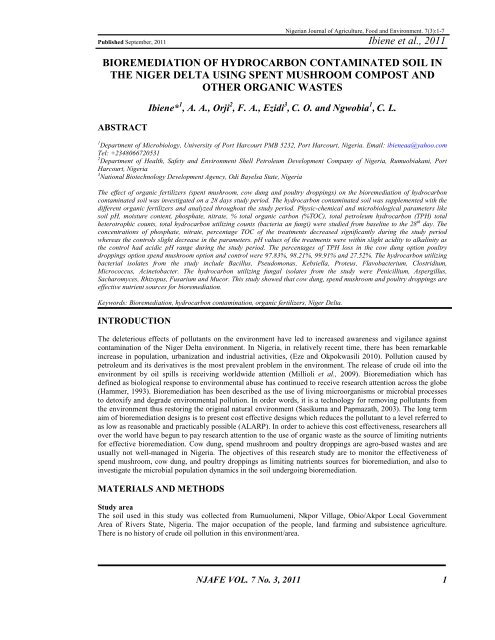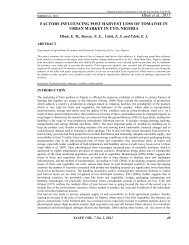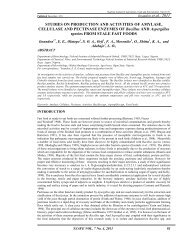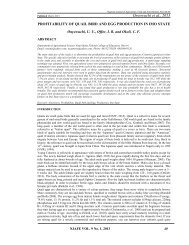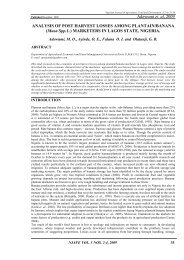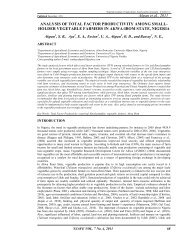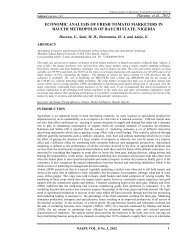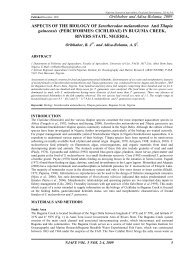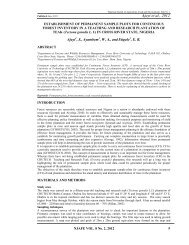Ibiene et al., 2011 BIOREMEDIATION OF ... - Njafe.org
Ibiene et al., 2011 BIOREMEDIATION OF ... - Njafe.org
Ibiene et al., 2011 BIOREMEDIATION OF ... - Njafe.org
You also want an ePaper? Increase the reach of your titles
YUMPU automatically turns print PDFs into web optimized ePapers that Google loves.
Nigerian Journ<strong>al</strong> of Agriculture, Food and Environment. 7(3):1-7<br />
Published September, <strong>2011</strong> <strong>Ibiene</strong> <strong>et</strong> <strong>al</strong>., <strong>2011</strong><br />
<strong>BIOREMEDIATION</strong> <strong>OF</strong> HYDROCARBON CONTAMINATED SOIL IN<br />
THE NIGER DELTA USING SPENT MUSHROOM COMPOST AND<br />
OTHER ORGANIC WASTES<br />
ABSTRACT<br />
<strong>Ibiene</strong>* 1 , A. A., Orji 2 , F. A., Ezidi 3 , C. O. and Ngwobia 1 , C. L.<br />
1 Department of Microbiology, University of Port Harcourt PMB 5232, Port Harcourt, Nigeria. Email: ibieneaa@yahoo.com<br />
Tel: +2348066720531<br />
2 Department of He<strong>al</strong>th, Saf<strong>et</strong>y and Environment Shell P<strong>et</strong>roleum Development Company of Nigeria, Rumuobiakani, Port<br />
Harcourt, Nigeria<br />
3 Nation<strong>al</strong> Biotechnology Development Agency, Odi Bayelsa State, Nigeria<br />
The effect of <strong>org</strong>anic fertilizers (spent mushroom, cow dung and poultry droppings) on the bioremediation of hydrocarbon<br />
contaminated soil was investigated on a 28 days study period. The hydrocarbon contaminated soil was supplemented with the<br />
different <strong>org</strong>anic fertilizers and an<strong>al</strong>yzed throughout the study period. Physic-chemic<strong>al</strong> and microbiologic<strong>al</strong> param<strong>et</strong>ers like<br />
soil pH, moisture content, phosphate, nitrate, % tot<strong>al</strong> <strong>org</strong>anic carbon (%TOC), tot<strong>al</strong> p<strong>et</strong>roleum hydrocarbon (TPH) tot<strong>al</strong><br />
h<strong>et</strong>erotrophic counts, tot<strong>al</strong> hydrocarbon utilizing counts (bacteria an fungi) were studied from baseline to the 28 th day. The<br />
concentrations of phosphate, nitrate, percentage TOC of the treatments decreased significantly during the study period<br />
whereas the controls slight decrease in the param<strong>et</strong>ers. pH v<strong>al</strong>ues of the treatments were within slight acidity to <strong>al</strong>k<strong>al</strong>inity as<br />
the control had acidic pH range during the study period. The percentages of TPH loss in the cow dung option poultry<br />
droppings option spend mushroom option and control were 97.83%, 98.21%, 99.91% and 27.52%. The hydrocarbon utilizing<br />
bacteri<strong>al</strong> isolates from the study include Bacillus, Pseudomonas, Kebsiella, Proteus, Flavobacterium, Clostridium,<br />
Micrococcus, Acin<strong>et</strong>obacter. The hydrocarbon utilizing fung<strong>al</strong> isolates from the study were Penicillium, Aspergillus,<br />
Sacharomyces, Rhizopus, Fusarium and Mucor. This study showed that cow dung, spend mushroom and poultry droppings are<br />
effective nutrient sources for bioremediation.<br />
Keywords: Bioremediation, hydrocarbon contamination, <strong>org</strong>anic fertilizers, Niger Delta.<br />
INTRODUCTION<br />
The del<strong>et</strong>erious effects of pollutants on the environment have led to increased awareness and vigilance against<br />
contamination of the Niger Delta environment. In Nigeria, in relatively recent time, there has been remarkable<br />
increase in population, urbanization and industri<strong>al</strong> activities, (Eze and Okpokwasili 2010). Pollution caused by<br />
p<strong>et</strong>roleum and its derivatives is the most prev<strong>al</strong>ent problem in the environment. The release of crude oil into the<br />
environment by oil spills is receiving worldwide attention (Millioli <strong>et</strong> <strong>al</strong>., 2009). Bioremediation which has<br />
defined as biologic<strong>al</strong> response to environment<strong>al</strong> abuse has continued to receive research attention across the globe<br />
(Hammer, 1993). Bioremediation has been described as the use of living micro<strong>org</strong>anisms or microbi<strong>al</strong> processes<br />
to d<strong>et</strong>oxify and degrade environment<strong>al</strong> pollution. In order words, it is a technology for removing pollutants from<br />
the environment thus restoring the origin<strong>al</strong> natur<strong>al</strong> environment (Sasikuma and Papmazath, 2003). The long term<br />
aim of bioremediation designs is to present cost effective designs which reduces the pollutant to a level referred to<br />
as low as reasonable and practicably possible (ALARP). In order to achieve this cost effectiveness, researchers <strong>al</strong>l<br />
over the world have begun to pay research attention to the use of <strong>org</strong>anic waste as the source of limiting nutrients<br />
for effective bioremediation. Cow dung, spend mushroom and poultry droppings are agro-based wastes and are<br />
usu<strong>al</strong>ly not well-managed in Nigeria. The objectives of this research study are to monitor the effectiveness of<br />
spend mushroom, cow dung, and poultry droppings as limiting nutrients sources for bioremediation, and <strong>al</strong>so to<br />
investigate the microbi<strong>al</strong> population dynamics in the soil undergoing bioremediation.<br />
MATERIALS AND METHODS<br />
Study area<br />
The soil used in this study was collected from Rumuolumeni, Nkpor Village, Obio/Akpor Loc<strong>al</strong> Government<br />
Area of Rivers State, Nigeria. The major occupation of the people, land farming and subsistence agriculture.<br />
There is no history of crude oil pollution in this environment/area.<br />
NJAFE VOL. 7 No. 3, <strong>2011</strong> 1
Nigerian Journ<strong>al</strong> of Agriculture, Food and Environment. 7(3):1-7<br />
Published September, <strong>2011</strong> <strong>Ibiene</strong> <strong>et</strong> <strong>al</strong>., <strong>2011</strong><br />
Collection of samples<br />
Samples were collected using soil auger; this was done 15cm deep, at four different points. The four soil samples<br />
were lumped tog<strong>et</strong>her in a plastic part and transported to the environment<strong>al</strong> microbiology laboratory of the<br />
University of Port Harcourt for bioremediation studies. Spend mushroom used was obtained from Bioresource<br />
Development Center Odi, Bayelsa State Nigeria. The cow dung was obtained from cattle abattoir, Alakahia, Port<br />
Harcourt (Nigeria) whereas the poultry droppings were collected from poultry farms in Alakahia, Port Harcourt,<br />
Nigeria. Five hundred (500) grams of soils in the four containers were supplemented with 50mls of Bonny light<br />
crude oil containers to simulate conditions for a major spill. Each of these containers were mixed with either 50<br />
grams of cow dungs, spent mushroom or poultry droppings. One of the four (4) containers was not amended with<br />
<strong>org</strong>anic fertilizers to serve as control (table 2).<br />
Table 1: Experiment<strong>al</strong> design<br />
Experiment<strong>al</strong> s<strong>et</strong><br />
S<strong>et</strong> A<br />
S<strong>et</strong> B<br />
S<strong>et</strong> C<br />
S<strong>et</strong> D (control)<br />
Test experiment<br />
500grams of polluted soil + 50 grams of cow dung (CD)<br />
500grams of polluted soil + 50 grams of poultry droppings (PD)<br />
500grams of polluted soil + 50 grams of spent mushroom<br />
500grams of polluted soil + no amendment<br />
Microbiologic<strong>al</strong> an<strong>al</strong>yses of the samples<br />
Enumeration of tot<strong>al</strong> culturable h<strong>et</strong>erotrophic bacteri<strong>al</strong> and fung<strong>al</strong> counts<br />
Ten-fold seri<strong>al</strong> dilution was done, one gram of the soil samples was weighed out from each samples and dispensed<br />
into the first three test tubes containing norm<strong>al</strong> s<strong>al</strong>ine. Each tube was shaken for thorough mixing of the mixture.<br />
1ml was pip<strong>et</strong>ted into another test tube containing 9mls norm<strong>al</strong> s<strong>al</strong>ine to give a 10 -1 dilution. The sample was<br />
diluted seri<strong>al</strong>ly up to 10 -5 . The same procedure was followed for other samples. The test tubes were covered with<br />
cotton wool. Exactly 0.1ml <strong>al</strong>iquots of the dilutions was spread inoculated into P<strong>et</strong>ri dishes containing nutrients<br />
agar (Oxoid) and potatoes dextrose agar (PDA, Antech) for tot<strong>al</strong> culturable bacteria and tot<strong>al</strong> cultur<strong>al</strong> fungi<br />
enumeration respectively (Chikere <strong>et</strong> <strong>al</strong>., 2009; Orji, <strong>2011</strong>). Enumeration of colonies was done through the<br />
formula:<br />
Enumeration of tot<strong>al</strong> culturable hydrocarbon utilizing bacteri<strong>al</strong> and fung<strong>al</strong> counts<br />
The culturable hydrocarbon utilizing bacteria of the soil samples were enumerated in duplicates on modified<br />
miner<strong>al</strong> s<strong>al</strong>t agar (MSA) of mills <strong>et</strong> <strong>al</strong>., 1978 using the spread plate m<strong>et</strong>hod. The vapour phase transfer was used.<br />
Seri<strong>al</strong> dilution of each sample was carried by suspending 1gram of the sample into 9mls of norm<strong>al</strong> s<strong>al</strong>ine and<br />
0.1ml of the appropriate dilution was inoculated onto a duplicate agar plate. A sterile filter paper (Whatman No 1)<br />
saturated with crude oil was placed inside the cover of the p<strong>et</strong>ri dish, closed, inverted and incubated at 28 0 C for 5-<br />
8 days. The filter paper saturated with crude oil served as a sole source of carbon (Abu and Ogiji, 1995).<br />
Enumeration of culturable hydrocarbon utilizing fungi<br />
The same procedure used for the enumeration of hydrocarbon utilizing bacteria was adopted except that 1ml of<br />
lactic acid was added for the fung<strong>al</strong> media to inhibit the growth of hydrocarbon utilizing bacteri<strong>al</strong> (Obire <strong>et</strong>. <strong>al</strong>.,<br />
2008).<br />
Isolate purification<br />
The colonies formed on MSA for bacteria were further purified by sub-utilizing on nutrient agar. Pure colonies<br />
were identified based on the size, shape, colour elevation, gram reactions and biochemic<strong>al</strong> characteristics.<br />
Isolates on MSA for fungi were purified by sub-culturing on potato dextrose agar. Pure fung<strong>al</strong> isolates were<br />
further studied using lactophenol stain. A sm<strong>al</strong>l portion of the fung<strong>al</strong> growth was picked with a wire loop and<br />
placed on clean and grease free slide. A drop of lactophenol was added and the preparation was covered with<br />
cover slip. The slide was observed under x 10 and 40 objectives lenses. (Obire <strong>et</strong>.<strong>al</strong>, 2008)<br />
Physico-chemic<strong>al</strong> an<strong>al</strong>yses<br />
The param<strong>et</strong>ers studied were the soil pH, nitrate, phosphate, tot<strong>al</strong> p<strong>et</strong>roleum hydrocarbon (TPH), tot<strong>al</strong> <strong>org</strong>anic<br />
carbon (% TOC) and moisture content (Jamie and Richard, 1996). The d<strong>et</strong>ermination of tot<strong>al</strong> <strong>org</strong>anic carbon (%)<br />
was done by titration m<strong>et</strong>hod using potassium per manganate as oxidant whereas the moisture content was<br />
d<strong>et</strong>ermined using the m<strong>et</strong>hod previously described by Stewart <strong>et</strong> <strong>al</strong>., 1974.<br />
Gas chromatography (GC) an<strong>al</strong>ysis<br />
NJAFE VOL. 7 No. 3, <strong>2011</strong> 2
Nigerian Journ<strong>al</strong> of Agriculture, Food and Environment. 7(3):1-7<br />
Published September, <strong>2011</strong> <strong>Ibiene</strong> <strong>et</strong> <strong>al</strong>., <strong>2011</strong><br />
The extraction of p<strong>et</strong>roleum hydrocarbon was done with dichlorom<strong>et</strong>hane (DCM) using cold extraction m<strong>et</strong>hod<br />
with ASTM D-3694 heavy machine for 1 hour. Procedur<strong>al</strong>ly, 20 grams of dried soil samples was weighed into<br />
100mls conic<strong>al</strong> flask. Twenty (20) grams of activated anhydrous sodium sulphate and 20 mls of DCM were gently<br />
added into the barrier containing the test soil sample.<br />
This was <strong>al</strong>lowed to stand for 1 hour and then filtered into 50mls conic<strong>al</strong> flask using filtration plugged/packed<br />
with cotton wool. Procedure was repeated on the residu<strong>al</strong> soil until a colourless solution is obtained (Saari <strong>et</strong> <strong>al</strong>.,<br />
2007).<br />
RESULTS AND DISCUSSIONS<br />
The baseline study showed that tot<strong>al</strong> culturable h<strong>et</strong>erotrophic bacteria count was 6.4 x 10 4 Cfu/gram. In addition,<br />
the tot<strong>al</strong> culturable h<strong>et</strong>erotrophic fung<strong>al</strong> count, tot<strong>al</strong> hydrocarbon utilizing bacteria, tot<strong>al</strong> culturable hydrocarbon<br />
utilizing fung<strong>al</strong> counts were 2.6 x 10 3 Cfu/g, 3.9 x 10 3 Cfu/g and 1.2 x 10 3 Cfu/g respectively. (Table 2). This<br />
table shows that the hydrocarbon utilizing bacteria in the mangrove soil is relatively adequate for bioremediation<br />
(Ebuehi <strong>et</strong> <strong>al</strong>., 2005).However, the amount of limiting nutrients such as nitrogen and phosphorus present in this<br />
polluted soil are very low. The tot<strong>al</strong> culturable h<strong>et</strong>erotrophic bacteri<strong>al</strong> count in the cow dung, poultry droppings,<br />
and spend mushroom increased progressively from 4.2 x 10 4 Cfu/g to 6.8 x 10 Cfu/g, 4.9 x 10 4 Cfu/g to 1.12 x 10 6<br />
Cfu/g and 4.6 x 10 6 to 1.3 x 10 5 Cfu/g respectively (Figure 1). The tot<strong>al</strong> culturable hydrocarbon utilizing bacteri<strong>al</strong><br />
count for the cow dung, poultry dropping spent mushroom amended soil and control increased from 2.1 x 10 3<br />
Cfu/g to 2.9 x 10 6 Cfu/g, 1.8 x 10 3 Cfu/g in 3.2 x 10 6 Cfu/g, 2.9 x 10 3 Cfu/g to 5.4 x 10 6 Cfu/g and 3.4 x 10 3 to 2.9<br />
x 10 5 Cfu/g (figure 2). The tot<strong>al</strong> culturable h<strong>et</strong>erotrophic fung<strong>al</strong> count for the cow dung, poultry droppings spent<br />
mushroom amended polluted and control increased 2.6 x 10 3 Cfu/g to 6.3 x 10 4 Cfu/g, 2.0 x 103 Cfu/g to 6.6 x 10 4<br />
Cfu/g, 2.2 x 10 3 to 7.9 x 10 4 Cfu/g and 2.7 x 10 3 Cfu/g to 2.8 x 10 4 Cfu/g respectively (figure 3). The tot<strong>al</strong><br />
culturable hydrocarbon utilizing fungi count ranged b<strong>et</strong>ween 1.3 x 10 3 to 5.4 x 10 4 Cfu/g, 1.6 x 10 3 to 6.0 x 10 4<br />
Cfu/g, 1.4 x 10 3 Cfu/g to 5.3 x 10 5 Cfu/g and 1.2 x 10 3 Cfu/g to 2.9 x 10 Cfu/g for cow dung, poultry droppings,<br />
spent mushroom and control respectively (Figure 4). Obire <strong>et</strong> <strong>al</strong>., 2008 in a bioremediation study using cow dung<br />
and poultry droppings reported an average h<strong>et</strong>erotrophic fung<strong>al</strong> count of 32.25 x 10 2 cfu/gram and 46.84 x<br />
10 5 cfu/gram for cow dung and poultry droppings respectively.<br />
However, in a laboratory sc<strong>al</strong>e bioremediation study, 500grams of the polluted soil was amended with either<br />
50grams of cow dung or 50grams of water hyacinth recipe and the control experiment. The tot<strong>al</strong> culturable<br />
h<strong>et</strong>erotrophic bacteri<strong>al</strong> and fung<strong>al</strong> count and hydrocarbon utilizers for the two treatments increased progressively<br />
from the 28 th day to the 70 th day of the study. The baseline percentage <strong>org</strong>anic carbon (%TOC) was 3.97%<br />
amendment with <strong>org</strong>anic nutrients increased the tot<strong>al</strong> <strong>org</strong>anic carbon to 41.45%, 40.11%, 44.32%, 3.90% for the<br />
cow dung, poultry droppings, spent mushroom and control respectively (Table 2). There were progressive<br />
decrease in the %TOC from 41.45% to 26.00%, 40.11%-24.00%, 44.22%-21% and 3.97%-2.85% for cow dung,<br />
poultry droppings, spent mushroom and control options respectively from day 0 to 28 th day of the study (Figure<br />
7). The baseline concentration of phosphate was 6.65mg/kg. Thereafter amendment, this increased to 29.00mg/kg,<br />
34.20mg/kg, 47.79 mg/kg in the cow dung, poultry droppings and spent mushroom respectively. During the 28 th<br />
days bioremediation study, the phosphate level decreased from 29.00mg/kg-9.25mg/kg, 34.20mg/kg-11.40mg/kg,<br />
47.79mg/kg-6.70mg/kg, and 6.60-5.00mg/kg (Figure 5) for the cow dung, poultry droppings, spent mushroom and<br />
control respectively.<br />
The baseline concentration of nitrate in the polluted soil was 5.8mg/kg, thereafter commandment; the nitrate<br />
concentration increased to 12.20mg/kg, 14.11mg/kg, 18.50mg/kg, for the cow dung, poultry droppings, and spent<br />
mushroom options respectively. The concentration of nitrate decreased from 12.20mg/kg to 6.50mg/kg, 14.11-<br />
7.11, 18.50mg/kg to 5.29, 5.75 to 3.00 for the cow dung, poultry droppings, spent mushroom and control options<br />
(Figure 6).<br />
The baseline amount of tot<strong>al</strong> p<strong>et</strong>roleum hydrocarbon (TPH) was 639.11± 0.11 PPm. The monitoring of<br />
bioremediation was done at zero day, 8 th day and 28 th day (Figure 8). On the 8 th day of the study, the TPH in cow<br />
dung reduced from 633.46 to 374.00PPm. This is about 41.48% reduction or loss in TPH form the environment.<br />
Still in the cow dung treated polluted soil, the TPH reduced to 13.88PPM at the 28 th day. This represents 97.82%<br />
loss of TPH. In the poultry dropping option, the TPH reduced to 393.14 PPm on the 8 th day. This represents about<br />
38.64% loss in TPH. On the 28 th day, the poultry dropping option had only 11.34PPm of TPH left. This represents<br />
98.20% loss in TPH. In the spent mushroom option, the TPH reduced from 633.46 to 278.72 PPm (on the 8 th day).<br />
This represents 38.64% percentage loss in TPH. On the 28 th day, the TPH reduced to 0.57 indicating 99.9% loss<br />
of TPH (Figure 8). The control experiment<strong>al</strong> s<strong>et</strong>-up, without amendment had reduction of TPH from 640.38 (day<br />
NJAFE VOL. 7 No. 3, <strong>2011</strong> 3
Nigerian Journ<strong>al</strong> of Agriculture, Food and Environment. 7(3):1-7<br />
Published September, <strong>2011</strong> <strong>Ibiene</strong> <strong>et</strong> <strong>al</strong>., <strong>2011</strong><br />
0) to 629.00 (28 th day). This represents 1.77% loss of TPH. On the 28 th day, the TPH in the control of 27.52%<br />
(Figure 8).<br />
In a crude oil contaminated agricultur<strong>al</strong> soil at Feder<strong>al</strong> University of Technology, Owerri -Nigeria, the amendment<br />
of 100grams of contaminated soil with 30 grams of <strong>org</strong>anic nutrient (poultry droppings) led to the loss of 40%<br />
tot<strong>al</strong> p<strong>et</strong>roleum hydrocarbon (Ibekwe <strong>et</strong> <strong>al</strong>., 2006). In bioreactor model, Indian scientists established<br />
bioremediation of diesel hydrocarbon polluted soil using ammonium nitrate (Sharma and Rehman, 2009). In a<br />
tropic<strong>al</strong> crude oil polluted soil undergoing bioremediation, Chikere <strong>et</strong> <strong>al</strong>., 2009b observed that the use of NPK<br />
fertilizer, urea fertilizer and poultry droppings effectively stimulated bacteri<strong>al</strong> <strong>org</strong>anisms into utilization of crude<br />
oil. NPK 20:10:10 fertilizer option reduced TPH from 3666.0mg/kg to 89.68mg/kg for 57 days where as urea<br />
fertilizer option reduced TPH from 3666mg/kg to 162mg/kg for 57 days. In the poultry droppings option, the TPH<br />
was reduced from 3666.0mg/kg of soil to 135.01mg/kg of soil (Chikere <strong>et</strong> <strong>al</strong>., 2009)<br />
CONCLUSION<br />
Waste utilization is currently receiving great research attention glob<strong>al</strong>ly, and the findings of this research work<br />
identified the usefulness of three wastes (spent mushroom, poultry droppings, and cow dung) in bioremediation of<br />
crude oil-impacted agricultur<strong>al</strong> soils in the Niger Delta. It is important to state categoric<strong>al</strong>ly that more funds and<br />
further research attentions are needed on the pilot sc<strong>al</strong>e and in-situ utilization of these wastes. This will enhance<br />
b<strong>et</strong>ter understanding of the interactions of environment<strong>al</strong> factors on the chemic<strong>al</strong>s of concerns (COC’s) and soil<br />
amendment agents ( i.e. these <strong>org</strong>anic wastes; spent mushroom, poultry droppings, and cow dung).<br />
Table 2: Baseline properties of the polluted soil<br />
Param<strong>et</strong>ers<br />
V<strong>al</strong>ues ± SD<br />
Tot<strong>al</strong> culturable h<strong>et</strong>erotrophic bacteri<strong>al</strong> count (Cfu/g) 6.4 x 10 4 ± 0.56<br />
Tot<strong>al</strong> culturable h<strong>et</strong>erotrophic fung<strong>al</strong> count (Cfu/g) 2.6 x 10 3 ± 0.31<br />
Tot<strong>al</strong> culturable hydrocarbon utilizing bacteri<strong>al</strong> count (Cfu/g) 3.9 x 10 3<br />
Tot<strong>al</strong> culturable hydrocarbon utilizing fung<strong>al</strong> count (Cfu/g) 1.2 x 10 3<br />
Nitrate (Mg/kg) 5.8 ± 0.02<br />
Phosphate (Mg/kg) 6.65 ± 0.04<br />
Tot<strong>al</strong> <strong>org</strong>anic carbon (%TOC) 3.97 ± 0.46<br />
Tot<strong>al</strong> p<strong>et</strong>roleum hydrocarbon (PPm) 639.11 ± 0.11<br />
Moisture (%) 27 ± 0.08<br />
pH 5.68 ± 0.05<br />
Cfu/g; colony forming unit/gram, Mg/kg: milligram per kilogram, PPm, part per million, % percentage<br />
Table 3: Bacteri<strong>al</strong> and fung<strong>al</strong> isolates utilizing or degrading P<strong>et</strong>roleum hydrocarbons<br />
Hydrocarbon utilizing bacteria<br />
Bacillus species<br />
Klebsiella species<br />
Acin<strong>et</strong>obacter species<br />
Farobacterium species<br />
Micrococcus species<br />
Clostridium species<br />
Pseudomonas species<br />
Hydrocarbon utilizing fungi<br />
Cladosporium species<br />
Aspergillus species<br />
Fusarium species<br />
Penicillium species<br />
Mucor species<br />
Saccharomyces species<br />
NJAFE VOL. 7 No. 3, <strong>2011</strong> 4
Nigerian Journ<strong>al</strong> of Agriculture, Food and Environment. 7(3):1-7<br />
Published September, <strong>2011</strong> <strong>Ibiene</strong> <strong>et</strong> <strong>al</strong>., <strong>2011</strong><br />
Figure 1: Changes in Tot<strong>al</strong> h<strong>et</strong>erotrophic bacteri<strong>al</strong> count during the study period<br />
Figure 2 : changes in the Tot<strong>al</strong> culturable hydrocarbon utilising bacteri<strong>al</strong> count during the study period<br />
Figure 3 : Tot<strong>al</strong> culturable h<strong>et</strong>erotrophic fungi during the study period<br />
Figure 4: Changes in the count of tot<strong>al</strong> culturable hydrocarbon utilizing fungi during the study<br />
NJAFE VOL. 7 No. 3, <strong>2011</strong> 5
Nigerian Journ<strong>al</strong> of Agriculture, Food and Environment. 7(3):1-7<br />
Published September, <strong>2011</strong> <strong>Ibiene</strong> <strong>et</strong> <strong>al</strong>., <strong>2011</strong><br />
Figure 5: Changes in the concentration of Phophate during the study period.<br />
Figure 6: Changes in the concentration of Nitrate during the study period<br />
Figure 7: Changes in the percentage tot<strong>al</strong> <strong>org</strong>anic carbon during the study period.<br />
Figure 8: Changes in the percentage Tot<strong>al</strong> P<strong>et</strong>roleum Hydrocarbon during the study period.<br />
Figure 9: Changes in the percentage Moisture content during the study period.<br />
NJAFE VOL. 7 No. 3, <strong>2011</strong> 6
Nigerian Journ<strong>al</strong> of Agriculture, Food and Environment. 7(3):1-7<br />
Published September, <strong>2011</strong> <strong>Ibiene</strong> <strong>et</strong> <strong>al</strong>., <strong>2011</strong><br />
REFERENCES<br />
Abu, G. O. and P. A. Ogiji (1995). Initi<strong>al</strong> test of a bioremediation scheme for the Clean-up of an Oil-polluted<br />
water body in a rur<strong>al</strong> community in Nigeria. Bioresource Technology, 58: 7-12.<br />
Chikere, C.B., G.C., Okpokwasili and B.O. Chikere (2009). Bacteri<strong>al</strong> diversity in a tropic<strong>al</strong> crude oil-polluted soil<br />
undergoing bioremediation. African Journ<strong>al</strong> of Biotechnology, 8 (11): 2535-2540.<br />
Ebuehi, O.A.T., I.B. Abibo, P.D. Shekwolo, K.I. Sigismund, A. Adoki, and I.C. Okoro (2005). Remediation of<br />
Crude oil contaminated soil by Enhanced natur<strong>al</strong> attenuation technique. Journ<strong>al</strong> of Applied Environment<strong>al</strong><br />
Management, 9(1): 103-106<br />
Eze, V.C, and Okpokwasili, G.C. (2010). Microbi<strong>al</strong> and other related changes in a Niger Delta River Sediment<br />
receiving Industri<strong>al</strong> effluents. Continent<strong>al</strong> Journ<strong>al</strong> of Microbiology, 4: 15-21.<br />
Hammer, G. (1993). Bioremediation: a response to gross environment<strong>al</strong> abuse. Trends Biotechnology, 11: 317-<br />
319.<br />
Ibekwe, V.I., K.C. Ubochi and E.U. Ezeji (2006). Effects of <strong>org</strong>anic nutrient on microbi<strong>al</strong> utilization of<br />
hydrocarbon on crude oil contaminated soil. African Journ<strong>al</strong> of Biotechnology, 5 (10): 983-986.<br />
Millioli VS, Servulo E.L.C, sobr<strong>al</strong>, L.G.S and De clor w. Iho, DE (2009). Bioremedation of crude of bearing soil:<br />
Ev<strong>al</strong>uating the effect of Rhamnnolipid addition to soil toxicity and to crude oil biodegration efficiency. Glob<strong>al</strong><br />
Nest Journ<strong>al</strong>. 11(2): 181-188.<br />
Mills, A.L., Breuil, C., and Colwell (1978). Enumeration of P<strong>et</strong>roleum degrading marine and estuarine<br />
micro<strong>org</strong>anisms by most probable number m<strong>et</strong>hod. Canadian Journ<strong>al</strong> of Microbiology, 12: 234-248.<br />
Obire, O., E.C. Anyanwu and R.N. Okigbo (2008). Saprophytic and crude oil degrading fungi from cow dung<br />
and poultry droppings as bioremediating agents. Journ<strong>al</strong> of Agricultur<strong>al</strong> Technology, 4 (92): 81-89<br />
Orji, F.A. (<strong>2011</strong>). Laboratory-Sc<strong>al</strong>e bioremediation of Crude –Oil polluted Mangrove Swamp in the Niger Delta<br />
using <strong>org</strong>anic nutrient. M.Sc. thesis submitted to the School of Graduate Studies, University of Port Harcourt,<br />
Nigeria. PP.154.<br />
Saari, E., P. Perämaki, and J. J<strong>al</strong>onen (2007). A comparative study of solvent extraction of tot<strong>al</strong> p<strong>et</strong>roleum<br />
hydrocarbons in soil. Microchim Acta, 158: 261-268.<br />
Sasikumar, C.S. and T. Papinaz<strong>et</strong>h (2003). Environment<strong>al</strong> management: bioremediation of polluted environment.<br />
Proceedings of the Third Internation<strong>al</strong> Conference on Environment<strong>al</strong> and he<strong>al</strong>th, Chennai, India. pp. 456-469.<br />
Sharma, A. and M. B. Rehman (2009). Laboratory sc<strong>al</strong>e bioremediation of diesel hydrocarbon in soil by<br />
indigenous bacteri<strong>al</strong> consortium. Indian Journ<strong>al</strong> of Experiment<strong>al</strong> Biology, 47: 766-769.<br />
Stewart, E.A. Grimshaw, J.A. and Parkinson, C.O. (1974). Chemic<strong>al</strong> an<strong>al</strong>yses of ecologic<strong>al</strong> materi<strong>al</strong>s. Blackwell<br />
Scientific publication, Oxford, pp. 187-190.<br />
NJAFE VOL. 7 No. 3, <strong>2011</strong> 7


